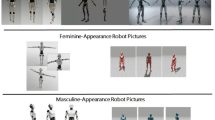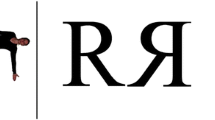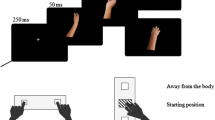Abstract
When actions are observed, individuals can automatically imitate them. Individuals could also change from imitating to being complementary with others in a context where feedback is required. This study investigated the influence of gender on the action response when agents were observed to execute dangerous actions. Experiments 1 and 2 included 30 males and 30 females, respectively. In Experiment 1, we established an imitation context of an agent operating a dangerous or neutral object. When the male agent reached and grasped a dangerous object, the imitation effect (facilitation effect when the agent’s action hand and the participant’s response hand were on a specular side) was observed for both male and female participants. This effect was not observed for either male or female participants when the agent was female. When the agent reached and grasped a neutral object, the imitation effect was obtained for both female and male participants. In Experiment 2, we establish a complementary context of an agent moving a dangerous or neutral object toward the participant. When the dangerous action was performed by the female agent, the complementary effect (facilitation effect when the agent's action hand and the participant’s response hand were on an anatomical side) was only observed for male participants. When a neutral action was observed, the complementary effect was found for both male and female participants. These results support and extend the view that the gender characteristics play an important role in the imitation of action and complementarity in a dangerous context.




Similar content being viewed by others
References
Anelli, F., Borghi, A. M., & Nicoletti, R. (2012). Grasping the pain: Action resonance with dangerous affordances. Consciousness and Cognition, 21, 1627–1639.
Avenanti, A., Bueti, D., Galati, G., & Aglioti, S. M. (2005). Transcranial magnetic stimulation highlights the sensorimotor side of empathy for pain. Nature Neuroscience, 8, 955–960.
Bekkering, H., Wohlschlager, A., & Gattis, M. (2000). Imitation of gestures in children is goal-directed. Quarterly Journal of Experimental Psychology, A, 53, 153–164.
Bertenthal, B. I., Longo, M. R., & Kosobud, A. (2006). Imitative response tendencies following observation of intransitive actions. Journal of Experimental Psychology: Human Perception and Performance, 32, 210–225.
Brass, M., Bekkering, H., Wohlschläger, A., & Prinz, W. (2000). Compatibility between observed and executed finger movements: Comparing symbolic, spatial, and imitative cues. Brain and Cognition, 143, 124–143.
Capellini, R., Sacchi, S., Ricciardelli, P., & Actis-Grosso, R. (2016). Social threat and action resonance: When a menacing outgroup delays action response. Frontiers in Psychology, 7, 1697.
Di Pellegrino, G., Fadiga, L., Fogassi, L., Gallese, V., & Rizzolatti, G. (1992). Understanding action events: A neurophysiological study. Experimental Brain Research, 91, 176–180.
Gallese, V., Fadiga, L., Fogassi, L., & Rizzolatti, G. (1996). Action recognition in the premotor cortex. Brain, 119, 593–609.
Gazzola, V., & Keysers, C. (2009). The observation and execution of actions share action and somatosensory voxels in all tested subjects: Single-subject analyses of unsmoothed fMRI data. Cerebral Cortex, 19, 1239–1255.
Heyes, C. (2011). Automatic imitation. Psychological Bulletin, 137, 463–483.
Hudson, M., Nicholson, T., Simpson, W. A., Ellis, R., & Bach, P. (2016). One step ahead: The perceived kinematics of others’ actions are biased toward expected goals. Journal of Experimental Psychology: General, 145, 1–7.
Kilner, J., Neal, A., Weiskopf, N., Friston, K., & Frith, C. (2009). Evidence of mirror neurons in human inferior frontal gyrus. The Journal of Neuroscience, 29, 10153–10159.
Koski, L., Iacoboni, M., Dubeau, M. C., Woods, R. P., & Mazziotta, J. C. (2003). Modulation of cortical activity during different imitative behaviors. Journal of Neurophysiology, 89, 460–471.
Liepelt, R., Prinz, W., & Brass, M. (2010). When do we simulate non-human agents? Dissociating communicative and non-communicative actions. Cognition, 115, 426–434.
Liuzza, M. T., Setti, A., & Borghi, A. M. (2012). Kids observing other kids’ hands: Visuomotor priming in children. Consciousness and Cognition, 21, 383–392.
Lugli, L., Obertis, A. C., & Borghi, A. M. (2017). Hitting is male, giving is female: Automatic imitation and complementarity during action observation. Psychological Research Psychologische Forschung, 81, 1180–1191.
Ocampo, B., & Kritikos, A. (2010). Placing actions in context: Action facilitation following observation of identical and non-identical manual acts. Experimental Brain Research, 201, 743–751.
Oosterhof, N. N., Wiggett, A. J., Diedrichsen, J., Tipper, S. P., & Downing, P. E. (2010). Surface-based information mapping reveals crossmodal vision-action representations in human parietal and occipitotemporal cortex. Journal of Neurophysiology, 104, 1077–1089.
Paulus, M. (2012). Action mirroring and action understanding: An ideomotor and attentional account. Psychological Research Psychologische Forschung, 76, 760–767.
Ranzini, M., Borghi, A. M., & Nicoletti, R. (2011). With hands I do not centre! Action- and object-related effects of hand-cueing in the line bisection. Neuropsychologia, 49, 2918–2928.
Rizzolatti, G., & Craighero, L. (2004). The mirror-neuron system. Annual Review of Neuroscience, 27, 169–192.
Rizzolatti, G., Fadiga, L., Fogassi, L., & Gallese, V. (1996). Premotor cortex and the recognition of action actions. Cognitive Brain Research, 3, 131–141.
Rizzolatti, G., Fogassi, L., & Gallese, V. (2001). Neurophysiological mechanisms underlying the understanding and imitation of action. Nature Reviews Neuroscience, 2, 661–670.
Sartori, L., Betti, S., & Castiello, U. (2013a). When mirroring is not enough: That is, when only a complementary action will do (the trick). NeuroReport, 24, 601–604.
Sartori, L., Bucchioni, G., & Castiello, U. (2013b). When emulation becomes reciprocity. Social Cognitive and Affective Neuroscience, 8, 662–669.
Stürmer, B., Aschersleben, G., & Prinz, W. (2000). Correspondence effects with manual gestures and postures: A study of imitation. Journal of Experimental Psychology: Human Perception and Performance, 26, 1746–1759.
Vainio, L., Tucker, M., & Ellis, R. (2007). Precision and power grip priming by grasp observation. Brain & Cognition, 65, 195–207.
Zhao, L., & Sang, N. (2020). The influence of visually dangerous information on imitation in children. Journal of Action Behavior, 52, 578–589.
Acknowledgements
This study was supported by the grant from Humanity and Social Science Youth foundation of Ministry of Education of China (22XJC190004) and the basic research program of Natural Science in Shaanxi Province (2020JQ-897).
Author information
Authors and Affiliations
Corresponding author
Ethics declarations
Conflict of interest
We declare that there is no conflict of interest.
Additional information
Publisher's Note
Springer Nature remains neutral with regard to jurisdictional claims in published maps and institutional affiliations.
Rights and permissions
Springer Nature or its licensor (e.g. a society or other partner) holds exclusive rights to this article under a publishing agreement with the author(s) or other rightsholder(s); author self-archiving of the accepted manuscript version of this article is solely governed by the terms of such publishing agreement and applicable law.
About this article
Cite this article
Zhao, L., Zhang, X. & Huyan, Y. The influence of agent’s gender on observer’s response in different action contexts. Curr Psychol 42, 29111–29121 (2023). https://doi.org/10.1007/s12144-022-03980-5
Accepted:
Published:
Issue Date:
DOI: https://doi.org/10.1007/s12144-022-03980-5




